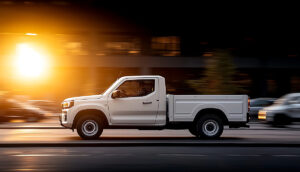
Pedestrians are at a clear disadvantage in car accidents. They don’t have the protective features of vehicles, such as bumpers, airbags, or safety alerts. Unlike motorcyclists, pedestrians aren’t equipped with helmets, padding, or any special gear. This imbalance makes collisions with pedestrians far more dangerous, increasing the risks significantly.
Now, imagine what would happen if cars continue to grow progressively without any limits, to the point where drivers lose direct visibility of what’s below their windshield.
This dangerous trend is already happening, and it’s no exaggeration. Recent research from the University of Wisconsin-Milwaukee has highlighted several key statistics.
Pickup trucks, in particular, are now nearly 1,256 pounds heavier (hence bigger)—a 32% increase—compared to their weight in 1990. The share of pedestrian fatalities involving trucks, vans, and SUVs has risen from 22% to 44% since the mid-1980s.
Increased Vehicle Height Means Increased Risk to Pedestrians
Recent research published by the Insurance Institute for Highway Safety (IIHS) reveals that vehicles with elevated front ends and blunt profiles are 45% more likely to result in pedestrian fatalities compared to smaller vehicles. Among vehicles with a hood height between 30 and 40 inches, those with a blunt front profile are 26% more likely to result in pedestrian fatalities than those with a sloped front design.
The research also highlights that elevated front ends strike pedestrians higher in the torso, causing them to be pushed forward and downward. This often results in more severe injuries, particularly to the head.
The impact of the person hitting the pavement happens more quickly, making it even more forceful.
An increase of just 4 inches in front-end height can raise the risk of pedestrian fatalities by 22%, as impacts are more likely to hit critical areas such as the chest or head.
SUVs Lead to Increased Risks for Pedestrians & Cyclists
It is estimated by academic papers that replacing larger vehicles with smaller cars in 2019 could have averted approximately 460 pedestrian deaths in the U.S. that year. Also, it was projected that capping front-end vehicle heights at 4.1 feet could reduce pedestrian fatalities in the U.S. by 509 each year.
Simulations have revealed that high-front vehicles cause pedestrians to hit the ground at greater speeds. Additionally, these computer models show that SUVs exert nearly twice the force on the brain as sedans when traveling at the same speed, which drastically raises the likelihood of severe injuries, even before the head makes direct contact.
A cyclist’s injuries in collisions with SUVs are significantly more serious than those involving cars, with a marked increase in the severity of head injuries in SUV-related crashes.
Driveways: A Trending Crash Spot
In Utah, 495 vehicle-pedestrian injuries were identified over a period of eight years, with 128 of these accidents occurring in driveways. The study reveals a concerning trend: larger vehicles, such as SUVs, trucks, and vans, were involved in a disproportionate number of these incidents. This is primarily due to their extensive blind spots, which hinder drivers’ ability to see pedestrians, particularly in the confined areas of driveways. Tragically, children under the age of 5 have been the most frequent victims of this troubling trend.
You Deserve an Advocate!
If you’ve been injured in a pedestrian accident, you need the best representation available. What you need is an Advocate on your side. Our experienced team is ready to listen to your story, assess the value of your accident claim, and then negotiate a just settlement for any injuries and losses you have suffered. Call our office for a free case evaluation.
